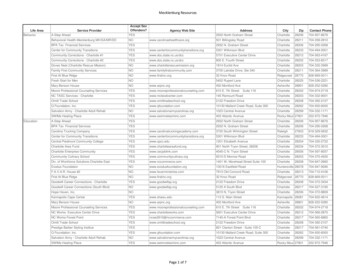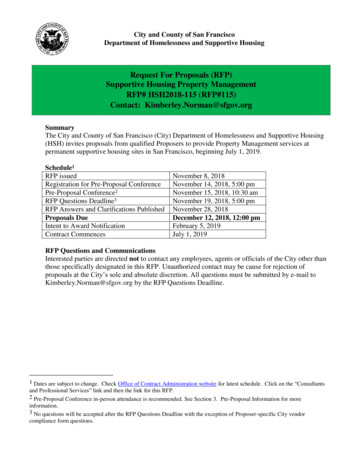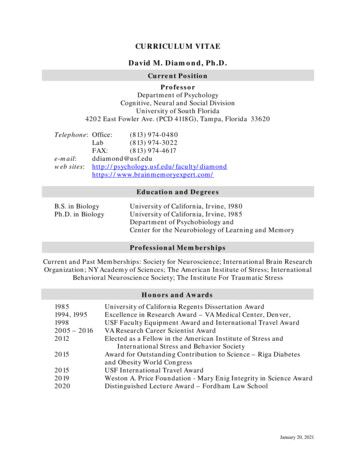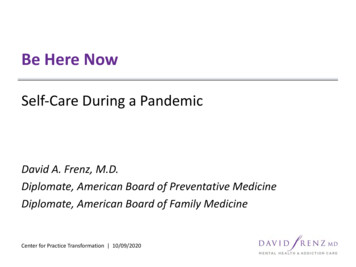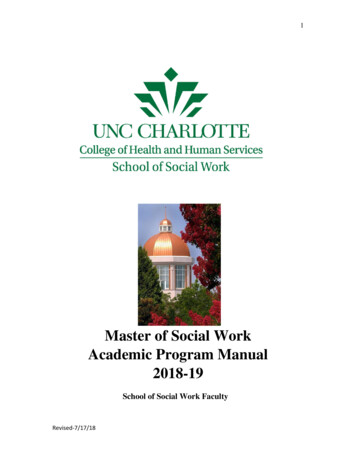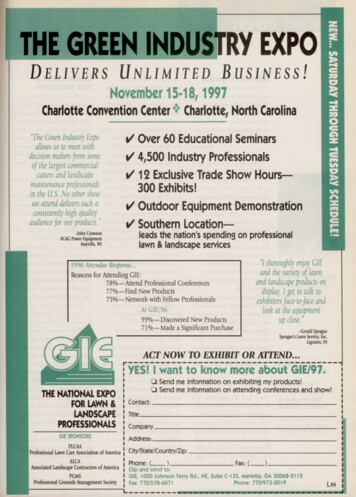
Transcription
THE GREEN INDUSTRY EXPODELIVERSUNLIMITEDBUSINESS!November 15-18,1997Charlotte Convention Center Charlotte, North Carolina"The Green Industry Expoallows us to meet withdecision makers from someof the largest commercialcutters and landscapemaintenance professionalsin the U.S. No other showwe attend delivers such aconsistently high qualityaudience for our products."-lohn CrowsonSCAC Power EquipmentMayviile, WI Over 60 Educational Seminars 4,500 Industry Professionals 12 Exclusive Trade Show Hours—300 Exhibits! Outdoor Equipment Demonstration Southern Location-leads the nation's spending on professionallawn & landscape services1996 Attendee Response.Reasons for Attending GIE:78%—Attend Professional Conferences77%—Find New Products75%—Network with Fellow ProfessionalsAt GIE/%:"I thoroughly enjoy GIEand the variety of lawnand landscape products ondisplay. I get to talk toexhibitors face-to-face andlook at the equipmentup close."99%—Discovered New Products71%—Made a Significant Purchase-Gerald SpragueSprague's Lawn Service, Inc.Ligonier, INACT NOW TO EXHIBIT OR ATTEND.YES! I want to know more about G IE/97*THE NATIONAL EXPOFOR LAWN &LANDSCAPEPROFESSIONALSGIE SPONSORSPLCAAI Professional Lawn Care Association of AmericaALCAAssociated Landscape Contractors of AmericaPGMSProfessional Grounds Management Society Send me information on exhibiting my products! Send me information on attending conferences and ntry/Zip:Fax: (Phone: (Clip and send to:GIE, 1000 Johnson Ferry Rd., NE, Suite C-135, Marietta, GA 30068-2112Fax: 770/578-6071Phone: 770/973-2019IILMI-J
ASK THE EXPERTScales on magnoliasBALAKRISHNA RAOManager of Research andTechnical Developmentfor the Davey Tree Co.Kent, OhioSEND YOURQUESTIONS TO:"Ask the Expert"Landscape Management7500 Old Oak Blvd.Cleveland, OH 44130Please allow two to threemonths for an answer toappear in the magazine.ber. The crawlers settle onWe see large, white bumpsleaves. Some of the populationwhich look like scale insects ondevelop into second instars bemagnolias. When mashed, theyfore cold weather and move tomake a mess. The leaves are coated branches to overwinter.with a black substance. How do weHorticultural oil treatmentsget rid of this insect and the black may be made in March or Aprilstuff on the leaves?prior to bud opening. Treat-MICHIGANments for crawlers would beprovided in late August and reMagnolia scale is large, for apeated at 10-14 day intervals.scale, that is—}4toXAinch long.You may need two applicationsFemales are dull grayish-brownper year, for two to three years,to dark brown. The over-winto manage this pest. If just onetering scale begins feeding infemale survives, the tree can belate spring or early summer andrepopulated quickly due to thematures by early August. Maglarge number of eggs that arenolia scale insects cause injuryproduced. Horticultural oil willby sucking the nutrients fromhelp preserve the natural predathe tree. They have mosquitotors and parasites that can helplike mouth parts and tap into aclean up the scales that mighttree's vascular pipeline tobe missed.siphon liquid and nutrients,Consider fertilizing the afwhich starve the tree. Thisfected trees with a slow releasecauses twigs and branches tonitrogen source to supplementshrivel and die.nutrient loss.Magnolia scales excrete theThe black stuff you refer toexcess fluids that they imbibe.is called "sooty mold" fungalFor some reason this bug excregrowth. This is a fungus growtion is called "honeydew" oring on honeydew. The fungus"ghost rain." You might notice itdoes not harm the plant diaccumulating on your car windrectly. However, if severeshield if you park under trees. Aenough, it can block sunlight toblack, sooty mold soon colonizes leaves. The combination of inthe honeydew that has accumusect feeding and sooty mold canlated on leaves or rooftops.weaken the plants.The adults of these ratherManaging the scales will takeodd-looking insects resemble acare of the sooty mold. You cancowry shell or a plant bud. Thisremove the fungus by sprayingis one reason they build up inthe leaves with the horticulturalsuch large numbers withoutoil. However, new infestation ofbeing noticed. They're noticedscale or other pests like aphidswhen the honeydew starts drip- can encourage sooty moldping. There is only one generagrowth. Continue monitoringtion per year, but each femalefor these sucking pests.can produce 500 to 1000 eggsin late August to early Septem-License needed totreat pasturelandOne of our customers has several acres which he wants us tomaintain for grazing dairy and beefcattle. He is interested in hiring usto control broadleaf weeds. Can weuse Trimec 899 herbicide to controlthe weeds? After treating, how longdoes he have to keep the cattle fromgrazing? Are there any other chemicals we can use?-WISCONSINTrimec 899 is not labeled foruse on pastures used for grazing.A PBI Co. representative saidthat another product, brandname of Hi-Dep herbicide, is labeled for pasture use forbroadleaf weeds. This is a mixture of two 2,4-D amine-containing herbicides. It containsDimethyl amine plus Di-ethylamine formulations of 2,4-D.This will help manage annualand perennial broadleaf weeds.One thing to know is thatHi-Dep is only labeled for agricultural use. If you only have aturf and ornamental spraying license, you will not be able topurchase or apply this product.You must have a special licenseto purchase and/or apply thisproduct. Contact your pesticidelicensing agency to verify thethings you need to do if you arestill interested in providing thisservice. Also be aware thatwhile using Hi-Dep the applicator must wear the proper personal protective equipment. It'son the label, as is the warning tokeep animals from grazing onthe treated property for 24 to48 hours. LM
When it comes to season-long control of crab-herbicide gets down to business. N o othergrass, goosegrass, oxalis, spurge and manypreemergent turf herbicide can match its spec-other troublesome weeds,trum of weeds controlled and cost-effective-PENDULUM ness. PENDULUM brand Pendimethalinalso offers greater flexibility than ever before,with a complete preemergent product linethat includes sprayable formulations, combination fertilizer products and HOW a 2%granular formulation. When you considercash rebates available to you from AmericanCyanamid, it's easy to see that PENDULUMreally does mean business. Smart Business. To learn more about the rebate offer or forthe name of the PENDULUM distributornearest you, call 1-800-545-9525, Ext. 931.ClTJkNJUVliD Trademark .American Cyanamid Company.Agricultural Products DivisionSpecialty Products DepartmentOne Campus Drive, Parsippany, NJ 07054-4492 1997
HOT TOPICSPLCAA considers giving new lifeto the 42-year-old Lawn InstituteMarietta, Ga.— On June 30,the executive committee ofThe Lawn Institute suspended operations of the 40year old turfgrass trade association. The Professional LawnCare Association is looking atways to revive it.Lawn Institute PresidentScott Patterson said the decision was made "due to insufficient interest and financialsupport from the turfgrassseed industry" over the lastseveral years."A number of sticks are inthe fire," said Patterson."There's been a number ofproposals, including the possibility of The Lawn Institutebeing united with an industryorganization such as the Professional Lawn Care Association of America (PLCAA).We're trying to make somedecisions now."PLCAA's Thomas Delaney acknowledged: "We'reworking with them to seehow we can either makethem a division [of PLCAA]or keep it going. . . We're trying to put a proposal togetherto see what we can do."Open up membershipDelaney said PLCAAwants to open the Lawn Institute's membership to all supplier categories, an ideawhose time has perhaps finally comeDr. Eliot Roberts, a pastexecutive director of The In-stitute, is one observer whobelieves the Institute's narrowmembership has limited theInstitute's success."I thought it should beopen to equipment manufacturers and chemical [companies] as well," Roberts said."The educational effortwould have been a benefit for"One of the key pointsthat has benefitted the landscape and lawn care industries has been the way it hasmatured over time. I don'tthink the lawn seed trade hasmatured over time. They'restill fighting over non-greenindustry issues. Instead ofworrying about whether oneRoberts: non-profitsJacklin: low mem-Brooks: don't yankneed money.bership a problem.plug on Institute.the whole of lawn care industry. We never got beyond aone-person, half-time executive director. If staff had increased at the same time ourbase of support increased, itmight have made a difference," suggested Roberts."Our top budget each yearwas just over 100,000," recalled Roberts. "You need atleast a quarter million for anon-profit [association] tomake an impact."Roberts believes politicswas one cause of lack of support for the Institute."The seedsmen have hadtheir agenda," said Roberts.company has an advantageover another they should bepromoting the lawn gardenand turf industry as a whole,not worry about their individual benefits.""Though the Lawn Institute has been very successfulin its consumer education andpublic relations efforts on behalf of the turfgrass industry,the current membership levelcannot financially sustain itsgrowing number of worthwhile activities," said DoyleJacklin, Jacklin Seed Co."We certainly hope a viableplan can be developed to expand the interest, participationand financial support from awider base of turf industrysuppliers and professionals."About 75 firms belong tothe Institute, but "without financial support, no organization is going to make it," emphasized Patterson.Institute began in '55The Institute began in1955 as The Better Lawn &Turf Institute, to promote research and education on thebenefits of lawn/sports turf."We felt the program hadvalue, but when crunch timecame, we were all busy," saidTom Stanley, marketing director for Turf-Seed. "We justdidn't want to put thosestickers on the bag, becauseit's another step before it getsout the door.""We educate people," saidJames Brooks, most recent director of the Institute."The Lawn Institute hasnever sold a bag of seed and Idon't think it ever will. Ourrole is to raise the consciousness of the homeowner andconsumer to where they'llsay, 'I want some of the goodstuff,'" when planting a newlawn."Let's not yank the plugon this thing," added Brooks."We're going to see if we cancome up with another plan."
Heat, drought and wear tolerant, new andimproved Mustang II produces an attractive,dark green turf that is resistant to manydiseases common to traditional tall fescue areas.Now endophyte enhanced, Mustang II is a long-timefavorite with many sod professionals.Sod professionals all over are turning to Pickseed withconfidence. High quality varieties and, most important,actual performance equal unparalleled results. Thesuperior turfgrasses you see here assure you the qualityyou deserve. Here's why:mienDark green with a dense, low growth habit,America also offers excellent shade tolerance,KENTUCKYBLUEGRASSsod strength and disease resistance. A provensod performer, alone or blended with other elite Kentucky bluegrasses.TouchdownAggressive and vigorous, Touchdown establishes rapidly to form adense, uniform, high quality turfthat crowds out Poa annua and tolerates low cutting heights. A topchoice of sod producers.KENTUCKY BLUEGRASSindinoLower growing with superior diseaseresistance, dark green color, shadeKENTUCKY BLUEGRASStolerance and excellent turf quality.Indigo is ideal for sod, and is well suited for all high quality Kentuckybluegrass blends.Low growing, fine textured and extremelycold tolerant, Alpine also features a verydark green color, good establishment andexcellent tolerance to low mowing to forma functional and attractive turf. An elite hybrid variety, Alpine is aperfect companion for other elite varieties such as Touchdown andAmerica for use in the highest quality seed blends.Fast-starting and durable, Bronco'sexceptional heat and drought toleranceKentucky Bluegrassm a k e U a str " * P ormer under thewarmer conditions of the TransitionZone. A unique variety, Bronco mixes exceptionally well with turf-typetall fescue and can also be blended with other bluegrasses.Dominating the recent National TUrf Trials,Crossfire has demonstrated reduced growthT U R F - T Y P E TALL F E S C U Ewith excellent vigor, superior dark greencolor and excellent disease resistance. An unexcelled performer, greatfor any sod application.i H i i i 9 r i l l E n C D r r r i f i r i f Pickseed's newest variety can take evenv i f j p j r i n c Hmore heat with an enhanced endophyteTURF-TYPE TALL FESCUEformulation of over 80%. Crossfire II alsofeatures a darker green color, improved turf quality and better heattolerance than its award-winning predecessor, making Crossfire II idealfor hotter areas of the country.The lowest and slowest growing variety inthe Pickseed stable, Mic-18 is also wellTURF-TYPE L4LL FESCUEadapted to summer stresses. Mic-18 is adark green, dense turf-type tall fescue with excellent turf quality.Blended with Shortstop II and Mini-Mustang into the Team Jr. blend,Mic-18 makes an excellent elite quality slower growing turf.shortstGHQflT&TQPMM P 11 takes the best of Shortstop —Mexcellent wear tolerance, exceptional turf quality, a fine-textured, dark green turfresistant to disease, heat and drought — and throws in better quality,color, leaf texture and a slower growth rate. It can be mowed moreclosely and will grow more slowly than any other variety in its class.Very low and slow growing, Mini-Mustang formsa dense, deep-rooted, dark green, high qualityturf. Destined to be a favorite among tall fescueT U R F - T Y P E TALL F E S C U Esod producers, Mini-Mustang can be used aloneor blended with Mic 18 and Shortstop II into the "Team Jr." formulation.mhmlsmfiPICKSEEDPICKSEED WEST Inc.You'll profit with Pickseed. Phone541-926-8886, and we'll prove it.Pickseed. It grows on you.P.O. Box 888 / Tangent, OR 97389Phone 541-926-8886 Fax 541-928-1599) 1997 Pickseed West, Inc.Pickseed is a trademark of Pickseed West, Inc.
HOT TOPICStrack surface with a 'bounce'Moisture levels are monitored at The Lone Star Park racing track.Grand Prairie, Texas—When the horses run the turftrack at the 96 million LoneStar Park here, there's moregoing on below the 48,000square yards of bermudagrassthan meets the eye. To makecertain Lone Star installedwhat they believed to be thebest surface possible, theywent to Dennis Moore, aworld renowned consultantand owner of Track Tek, Fallbrook, Calif.Moore designed a state-ofthe-art course, one that usesthe "Stabilizer" system, agrowing medium made fromLofts acquires bigdistributor in SouthLofts Seed, Inc., acquiredSunbelt Seeds, a wholesalegrass seed and fertilizer distributor in Norcross, Ga., onJune 18. Sunbelt Seeds isone of the largest golf coursedistributors in the South. Itwill be a subsidiary of LoftsSeed. It will sell seed to golfcourses, sod farms, retailstores, landscapers, lawncare operators, sports facilities and municipalities.Richard Budd, chief executive officer of Lofts Seed,Inc., said the acquisition"opens new market opportunities while maintaining thephilosophies which bothbusinesses were foundedon—customer relationshipsbuilt on trust, confidenceand professionalism."Lofts Seed is based inWinston-Salem, NC, andmarkets turfgrass seed. Itowns patents on more than25 seed varieties. The 74year-old company has morethan 100 employees. 80 percent sand and 20 percent organic material. The bottom layer of thecourse begins with a cementstabilized subgrade. Above that layer is sixinches of choker sand thatacts as a drainage system. Ten inches of Stabilizermix goes on top of the chokerlayer. The top four inches ofthe growing medium incorporates TurfGrids, fibrillatedpolypropylene fibers, tostrengthen the root systemand provide better footing forthe horses. Stabilizer, Inc. ofPhoenix, makes TurfGrids.The improved design is allmeant to make for betterfooting for the horses, and toreduce the beating to theturf.Sand alone simply doesnot provide enough supportfor racing, according toMoore. TurfGrids bind thesand and water together toproduce an equestrian surfacethat is resilient and has a goodwater bearing capacity."When the Stabilizer organic material is combinedwith the TurfGrids, the resultis much like the feel of atrampoline," says Moore."To maintain the effectiveness of this system, we maintain a damp soil consistency,"says Dennis' brother RonMoore, director of trackmaintenance for Lone StarPark.Ron Moore keeps a closeeye on soil moisture. A Toroirrigation system provides theneeded irrigation."The results have beentremendous with our equestrian surface," says Moore."Any needed repair isdone after each race, thoughwith this type of grass, thereare very few repairs. Wetamp it in and get water on itright away. That's basically allyou have to do."The rail can also be movedin or out to relieve turf wearduring the races. —Robert ReavesTurfGrids, fibrillated poly fibers, blended into this 80/20 plantingmedium provide stability to the bermudagrass racing surface.
A superchoice forcreatingpremiumturfPh.D. was originally formulated to meet thesuch as Top Hat, R.2, Essence , Gator II, Derby Supremedemanding needs of the southern winter overseedingand Regal are utilized to provide a dark, dense turf that ismarket and quickly became an industry leader. Coupledboth resilient and durable.with its ability for creating premium permanent turf inA mainstay for years on the practice and playing fieldsnorthern areas, it has become the nation's most widelyfor the NFL's Super Bowl, Ph.D. is also featured on award-used and recognized turfgrass blend.winning golf courses and sports complexes throughout thePh.D. is custom blended from three top-ratedperennial ryegrass varieties. Genetically diverse varietiesworld. Its unique components can also be expected toperform equally well on home lawns and parks.Circle No. 108 on Reader Inquiry Card
Recognized turf professionals choose Ph.D.for its unexcelled germination rate (7-10 daysunder normal conditions) and strong rootdevelopment. It also exhibits improved horizontaldisease resistance and above average performancein hot, humid conditions.Ph.D. will hold its color through the season,thrives when cut close (down to 3/e inch forspecialized uses) and maintains outstanding wear andstress tolerance. On golf course areas such as greens,tees and fairways, its rapid transitioning qualities makeit a peak performer.Growing conditions vary greatly, butPh.D. can be scientifically blended forproper regional adaptation, reducedmowing management, full endophyteenhancement and other factors importantto overall turf quality.It combines well with permanentpolyspecies turfgrass blends and mixturescontaining improved perennial ryegrass;Kentucky bluegrass; chewings, slendercreeping and strong creeping redfescues; colonial bentgrass and turf-typetall fescue.All these exceptional qualitiesexplain why satisfied turf managershave helped make Ph.D. the superchoice for premium turf.In northern California, look for Ph.D. under the brand name; Celebrity.PhD. Turf-type Perennial RyegrassTURF MAINTENANCE "MowingFreq.Traffic dToi.DroughtToi.ET Ratemm/dayEndophyteSalinity Toi.mmhosBunchFast7-10VeryGood2xweekVery 0TBDTBD"SeedtheG i f tofL i f e "i B inTERIHITIOnnii SEEDS, inc.P.O. Box 168 Halsey, Oregon 97-348 (541) 369-2251 Toll Free: 1-800-445-2251 FAX (541) 369-2640 intlseeds@intlseeds.comCircle No. 109 on Reader Inquiry Card
HOT TOPICSKillmer leads EnvironmentalEarthscapesKevin Killmer has been named president andchief executive officer of EnvironmentalEarthscapes, Inc., dba TheGroundskeeper, Tucson, Ariz.NY again in legislative tussleMembers of the NY State Green Council are looking with interest at S3889-B, "the adjacent notification bill," which they say could cripple manypesticide applications in New York State.The Council has begun to lobby Senator Carl Marcellino and other lawmakers to let them know why the proposed bill would be a mistake.As has happened before with pesticide legislation, the NY staters say priorbills have got it covered."Any concern about neighbors coming onto treated property is alreadycovered by ECL Article 33, Title 10, which requires sign posting for commercial lawn applications to warn persons coming onto treated propertyfrom adjoining properties. The purpose of this notification appears to presume that there will be off-premises contamination," wrote attorney ThomasWest in a letter to Marcellino, on behalf of the Council."Requiring off-premises notification in the manner prescribed by this billwill be cost-prohibitive, precluding many people from treating their property," wrote West. Many of the application techniques utilized would triggerthe off-premises notification requirements of this legislation. Very often, it isdifficult to determine who owns adjoining property or how many propertiesactually abut the premises being treated."West also noted technical flaws in the proposed legislation, flaws whichhe said would force a return to outdated, cover spray techniques of treatingan entire property to avoid having to notify neighbors if a spot treatment isrequired later."I remain committed to seeing legislation requiring notification of certainpesticide applications become a law," responded Marcellino in disagreement."Many hours have been spent working with interested parties on all sidesof the issue to craft a workable program to provide for neighbor notification."For more information on the bill, or to help the Council in its legislativebattle, call the Council at 518/783-1322. CflOKillmer has been with TheGroundskeepereueujfor more than 20 ]years, first as alandscape crewleader, then asJan area supervi-J)sor, and in 1985,as senior vp andgeneral manager. TheGroundskeeper is an employee-owned landscape Killmercontracting firm, with seven branch offices,in Tucson, Phoenix, Las Vegas and PalmDesert, Calif.Troutman with ECI on east coastDr. Barry Troutman is manager of technicalsupport for Environmental Care's east coast operations, reports ECI, Calabasas, Calif. He ischarged with management of technical programs for fertility, weed control and insect control. "Our industry faces the challenge of providing the environmentally important benefitsof landscapes in a world of limited resources,"says Troutman. "I see ECl's people and theirleadership in total landscape maintenancebusiness perfectly positioned to meet this challenge." Many know Troutman from his tenureas director of training for PLCAA. He was alsotechnical director and research weed scientistfor ChemLawn and past president of the Georgia Turfgrass Association. Toro alleges trade secret theftThe Toro Company's case against irrigation company Grizzle and Hunterwill be heard by a jury trial this fall.Toro is seeking to have the court remove the company's sprinkler productsfrom the market. The products are marketed under the trade name "Bear Irrigation".Toro claims that the company,owned by Glen Grizzle and several keyformer Toro employees, misappropriated several Toro secrets related to thegolf course sprinkler market.Toro also alleges that Grizzle andHunter has committed unfair competition and deceptive trade practices."Toro has carefully considered the situation and made the decision that itmust take protective action when Toro'sproprietary technology and informationis at risk," said Rick Parod, vice presidentand general manager of Toro's irrigationbusiness.
Golf course/grounds facility selections based on designfeatures, reputation and accessibility.Landscape/lawn care selections chosen forregional and/or national reputation, longeinty, accessibility and uniqueness.We could have included at least another hundred professionals in this feature. Nonetheless, we hope you findthis special feature to be informative, entertaining atiduseful. —The editorsShown cliKkwise from top right: Dallas Athletic Club; Dennis' Seven Dees employees; Beatrice CC; Lambeau Field.
Sep 11, 1997 · name of Hi-Dep herbicide, is la-beled for pasture use for broadleaf weeds. This is a mix-ture of two 2,4-D amine-con-taining herbicides. It contains Dimethyl amine plus Di-ethyl amine formulations of 2,4-D. This will help manage annual and perennial broadleaf weeds. One thing to know is that Hi-

